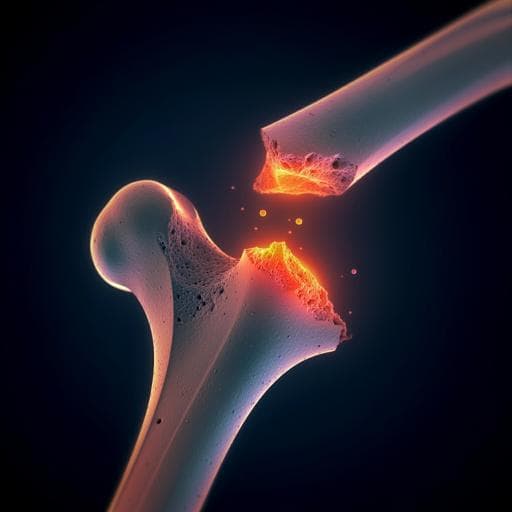
Engineering and Technology
Unraveling the effect of collagen damage on bone fracture using in situ synchrotron microtomography with deep learning
M. Sieverts, Y. Obata, et al.
This groundbreaking research, conducted by Michael Sieverts and colleagues, reveals how nanoscale collagen damage critically impacts bone fracture toughness. Utilizing advanced techniques like synchrotron radiation micro-computed tomography and deep learning, the study uncovers the mechanisms by which collagen damage influences crack growth and resistance in bone.
~3 min • Beginner • English
Introduction
Bone’s toughness arises from a hierarchical structure spanning the nano- to micro-scales. Mineral largely governs elastic properties and strength, while collagen contributes to post-yield behavior and failure energy. Collagen degradation/denaturation occurs in aging and multiple diseases and is associated with increased fracture risk. Toughening mechanisms comprise intrinsic (nanoscale, collagen-driven plasticity) and extrinsic (microscale, wake processes such as crack deflection and bridging), with crack deflection being the dominant extrinsic mechanism in cortical bone. Although extrinsic mechanisms often dissipate more energy, it is unclear whether intrinsic and extrinsic mechanisms act independently or cooperatively, and whether nanoscale collagen damage affects microscale extrinsic mechanisms. Synchrotron radiation micro-CT (SRµCT) enables in situ imaging of crack growth, and digital volume correlation (DVC) can quantify internal strains, but high radiation doses degrade bone mechanics. Low-dose imaging plus deep learning denoising can mitigate this. Hypothesis: alteration of the collagen network (modeled via heat-induced denaturation) decreases crack deflection and overall bone toughness. The study develops in situ SRµCT toughness testing with low-dose imaging and CNN denoising/segmentation to examine how collagen damage affects macroscale toughness, microscale crack deflection, and internal strain-guided crack evolution.
Literature Review
The paper situates bone toughness within a framework of intrinsic (collagen-mediated plasticity, influenced by cross-linking and sacrificial bonds) and extrinsic (microstructural features such as osteons and cement lines causing crack deflection/bridging) mechanisms. Prior work shows mineralization largely affects elastic behavior, while collagen governs post-yield properties and energy dissipation. SRµCT has been used to visualize crack paths and microstructure, and DVC has quantified strain, predominantly in trabecular bone. Radiation dose effects on bone mechanics necessitate low-dose imaging. Recent advances in deep learning, specifically CNNs and mixed-scale dense architectures, enable denoising and segmentation of low-quality tomographic images. Prior heat-treatment studies showed collagen denaturation in mineralized cortical bone above roughly 150–160 °C without altering mineral crystal structure below 200 °C, and that dehydration effects can be reversed by rehydration to preserve mechanics. Earlier studies linked collagen damage to reduced toughness and impaired fibril bridging, but the direct impact on crack deflection in cortical bone under in situ loading had not been quantified.
Methodology
Samples: Cortical bone from the posterior mid-diaphysis of 18-month-old female bovine femurs was machined into beams (1 × 2 × 10 mm). Toughness specimens were notched to 1 mm depth with ~5 µm root radius. Heat treatment: Samples were heated for 2 h at room temperature (RT), 100 °C, 130 °C, 160 °C, or 190 °C to induce graded collagen denaturation, then rehydrated in HBSS for ≥12 h.
Biochemical assay: Trypsin-hydroxyproline assay (N=8–11/group) quantified percent denatured collagen (DC). Demineralization in 10% EDTA, trypsin digestion (24 h), separation of supernatant (denatured collagen) and residue (undamaged collagen), acid hydrolysis, colorimetric hydroxyproline quantification, and DC percentage calculated relative to total collagen.
Flexural testing: Three-point bending per ASTM D790 (span 25.4 mm, rate 0.05 mm/min) on transverse orientation beams (N=6–8/group). Force–displacement at 20 Hz with low-pass filter; hydration maintained with PBS-soaked gauze. Derived stress–strain to compute ultimate strain, work to fracture, Young’s modulus.
In situ SRµCT toughness testing: Conducted at ALS beamline 8.3.2 in a custom 3-point bending chamber (span 6 mm) with immersion in HBSS (N=2/group). Imaging conditions: 24 keV, 100 ms exposure, voxel size 1.6 µm, 1-mm Al filter. Reference high-quality scan: 3937 projections (~10 kGy dose). Low-dose scans: 657 projections (1–2 kGy each). Total dose kept below ~35 kGy deleterious threshold. During loading (ASTM E1820 guidance), suspected crack growth was identified by force drop; loading paused for low-dose scan; repeated until failure. Reconstruction with TomoPy; visualization in Dragonfly/ImageJ.
R-curve calculation: From in situ load–displacement and SRµCT-measured crack extension Δa. Nonlinear fracture mechanics used to compute J (J_el + J_pl) and equivalent mode I K_I for each step, assuming mode I dominance. Young’s modulus from flexural tests. Validity checks for plane strain and plastic zone size were satisfied for specimen thickness.
Deep learning: Mixed-scale dense CNN (MS-D) with 100 layers used for denoising (regression) and crack segmentation (semantic). Training data: paired high/low-dose scans from 7 viable samples; images cropped to 1024×1024; slabs of 5 slices; ~3240 training, 680 validation, 662 test images for denoising. Loss: MSE; optimizer: Adam; 44 epochs; augmentation with flips. For segmentation: manual crack labels from final time points (~625 slices total); ~3124 training, 625 validation, 632 test images; loss: cross-entropy; performance evaluated by Dice coefficient.
Crack deflection quantification: CNN-segmented cracks at final time point were skeletonized. The gradient along the propagation direction was smoothed; large deflections identified using magnitude and angle thresholds (≥50 µm, ≥30°). OPTICS clustering grouped events. Metrics: deflection density (Df.Dn = number of deflections per mm of crack extension) and average deflection angle (Df.An). Two samples with insufficient propagation or excessive bifurcation excluded.
Digital volume correlation (DVC): Performed with TomoWarp2 on denoised volumes cropped to 400×300×300 voxels ahead of the crack tip, segmenting lacunae/canals/notch as speckle features. Correlation window 25 voxels; node spacing 10 voxels. Outlier/median filters applied; Green strains computed and upsampled with linear interpolation for visualization.
Statistics: R software. Two-group comparisons with unpaired two-tailed t-tests; multiple comparisons by ANOVA with Tukey post hoc; α=0.05. Bar data reported as mean ± SD.
Key Findings
- Collagen denaturation threshold: Trypsin–hydroxyproline assay showed minimal damage (≤3% DC) at RT, 100 °C, 130 °C, and a marked increase in DC at 160 °C and 190 °C, indicating onset of significant damage between 130 °C and 160 °C.
- Macroscale mechanics: Flexural tests (N=6–8/group) showed ultimate strain and work to fracture significantly reduced in 160 °C and 190 °C groups compared to lower temperatures (p < 0.001 for UC vs DC), while Young’s modulus was unchanged between UC and DC (p = 0.889). Tukey post hoc revealed specific between-group differences as noted in Fig. 2c–e.
- Fracture toughness (in situ SRµCT, N=2/group): Crack initiation toughness reduced by ~2–3× in DC vs UC (1.39 vs 3.15 MPa·m^1/2). R-curve slope (crack-growth toughness) in DC was ~one-third of UC. At Δa = 0.4 mm, UC toughness increased from ~2.5 to ~7 MPa·m^1/2 (nearly triple initiation), whereas DC increased from ~1 to ~2 MPa·m^1/2 (about double initiation).
- Crack deflection metrics: DC groups exhibited significantly lower crack deflection density (Df.Dn) and smaller average deflection angle (Df.An) than UC groups, indicating fewer and less severe deflections. Visualizations showed tortuous paths in UC vs straighter paths in DC.
- DVC-guided crack trajectory: Strain fields near crack initiation featured lobes of high strain; in UC, high strain extended laterally, and subsequent crack propagation followed these high-strain regions leading to deflections and tortuosity. In DC, strain was more confined near the crack tip and crack paths were more mode I dominated (straighter).
- Low-dose SRµCT enabled by CNN: Denoising reduced MSE by 85% and increased PSNR by 62% on test data. Segmentation achieved high Dice coefficients (0.96 validation, 0.93 test). CNN outputs exhibited improved bone–background contrast and bimodal histograms facilitating segmentation.
Discussion
The study directly tests the hypothesis that nanoscale collagen damage diminishes microscale crack deflection and overall toughness. Heat-induced collagen unfolding and damage, without altering mineral phase, impaired post-yield properties and fracture resistance: DC groups showed markedly reduced crack initiation and growth toughness, as well as decreased ultimate strain and work to fracture, while elastic modulus remained largely unaffected. Micromechanically, reduced crack deflection frequency and angle in DC groups demonstrates that intrinsic collagen integrity cooperatively influences extrinsic toughening mechanisms. DVC revealed that the internal strain state predicts the subsequent crack trajectory; in UC, broader lateral strain fields lead to deflection toward high-strain regions, whereas in DC, strain confinement corresponds to straighter, more brittle crack propagation. These results indicate that alterations in collagen’s plasticity at the nanoscale can propagate upward in scale to reduce extrinsic toughening and macroscale toughness. The integration of low-dose SRµCT with deep learning denoising/segmentation enabled dynamic, minimally damaging imaging and quantitative analysis of crack evolution, establishing a framework for assessing bone quality beyond mineral density, particularly relevant to conditions like aging, diabetes, and collagen-related pathologies.
Conclusion
Collagen damage induced by heat treatment significantly reduces bone’s fracture resistance by impairing both intrinsic plasticity and the dominant extrinsic toughening mechanism of crack deflection. Using a novel in situ SRµCT toughness testing approach with low-dose imaging and deep learning, the study quantified decreased R-curve behavior, reduced ultimate strain and work to fracture, and diminished crack deflection metrics in collagen-damaged cortical bone. DVC visualization showed that internal strain fields guide crack trajectories, with collagen integrity enabling more tortuous, energy-dissipating paths. This multi-scale linkage from nanoscale collagen quality to microscale mechanisms and macroscale toughness underscores the importance of assessing bone quality beyond mineral density. Future work should apply this technique to disease models (e.g., diabetes, osteoporosis, OI) and expand sample sizes to strengthen statistical power, validate DVC strain accuracy, and explore additional toughening mechanisms and microstructural factors.
Limitations
- Limited sample size for in situ SRµCT toughness tests (N=2/group) due to beamtime constraints; UC/DC grouping used to enable comparisons.
- Heat treatment is a model for collagen damage but not a direct analog of disease pathways; high temperatures may also affect cross-linking and mineral–collagen interface despite mineral phase remaining largely unchanged below 200 °C.
- Species/structure considerations: adult bovine cortical bone includes mixed Haversian/plexiform regions; study focused on Haversian-dominated posterior femoral mid-diaphysis, but some plexiform regions may persist, affecting generalizability to human bone.
- DVC limitations: potential overestimation of strain due to microcracks below the 1.6 µm voxel size; accuracy of computed strains not fully validated.
- Two samples excluded from crack deflection analysis due to insufficient propagation or excessive bifurcation; small N (1–2 per temperature) limits statistical analyses at individual temperature levels.
- Radiation management: although doses were controlled, cumulative exposure constraints limited number of imaging steps.
Related Publications
Explore these studies to deepen your understanding of the subject.







